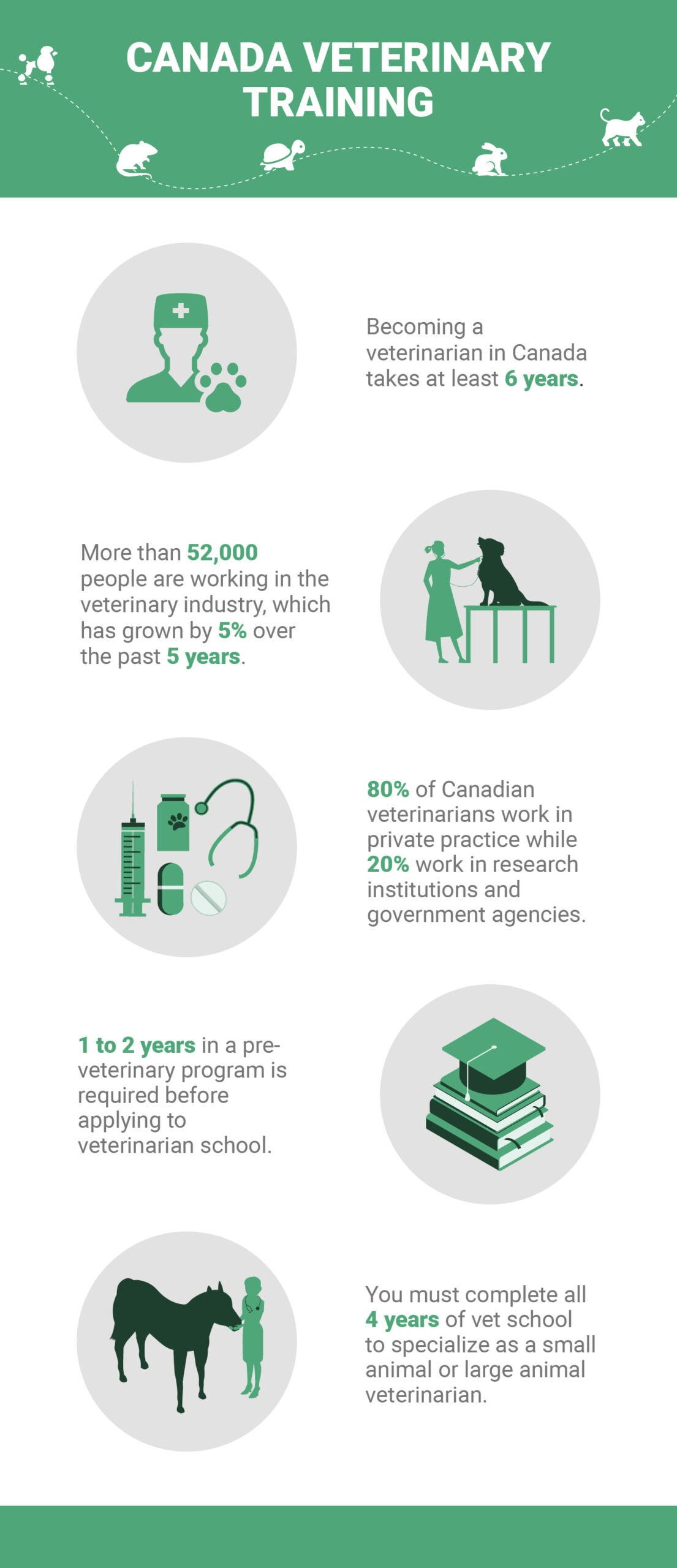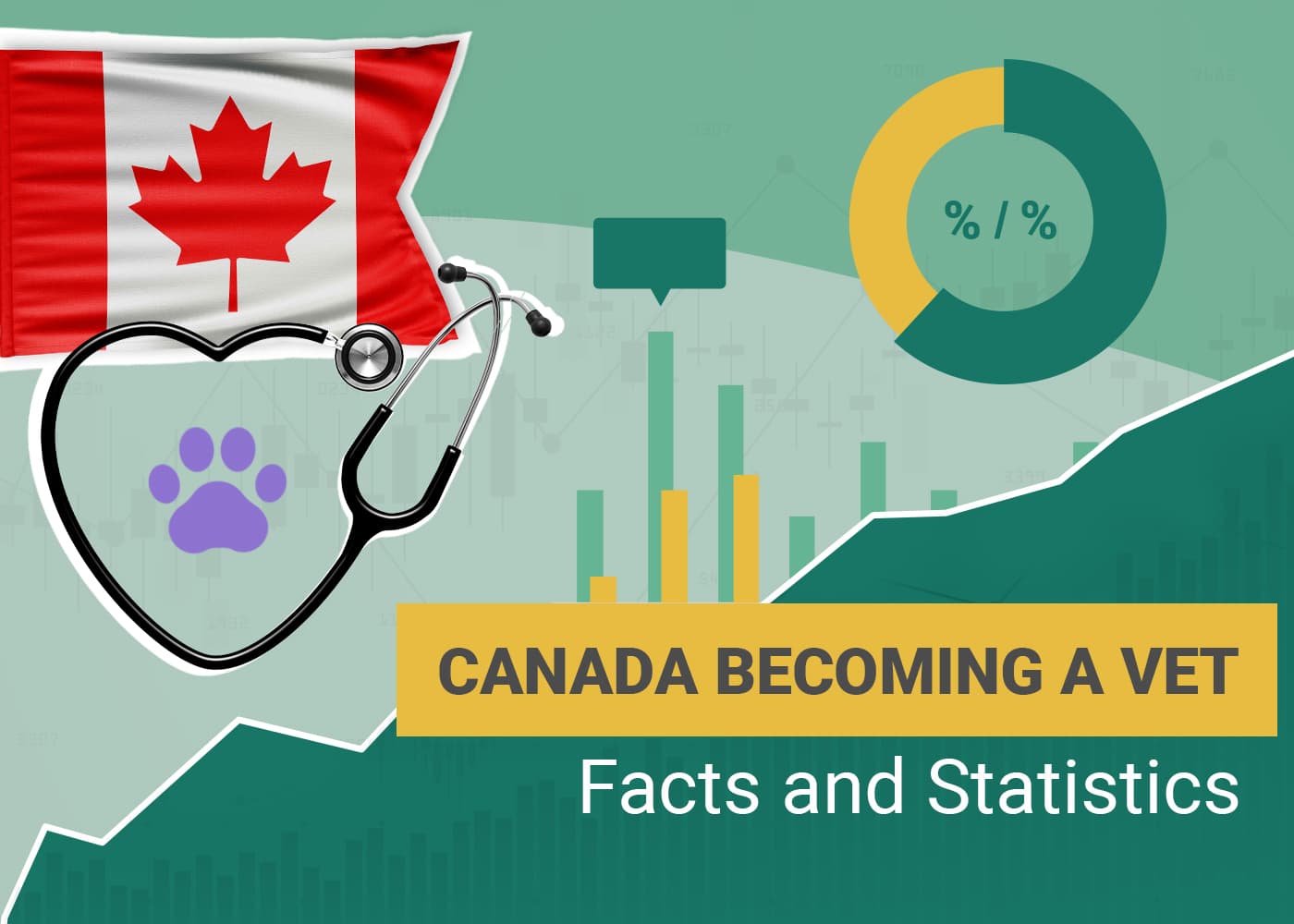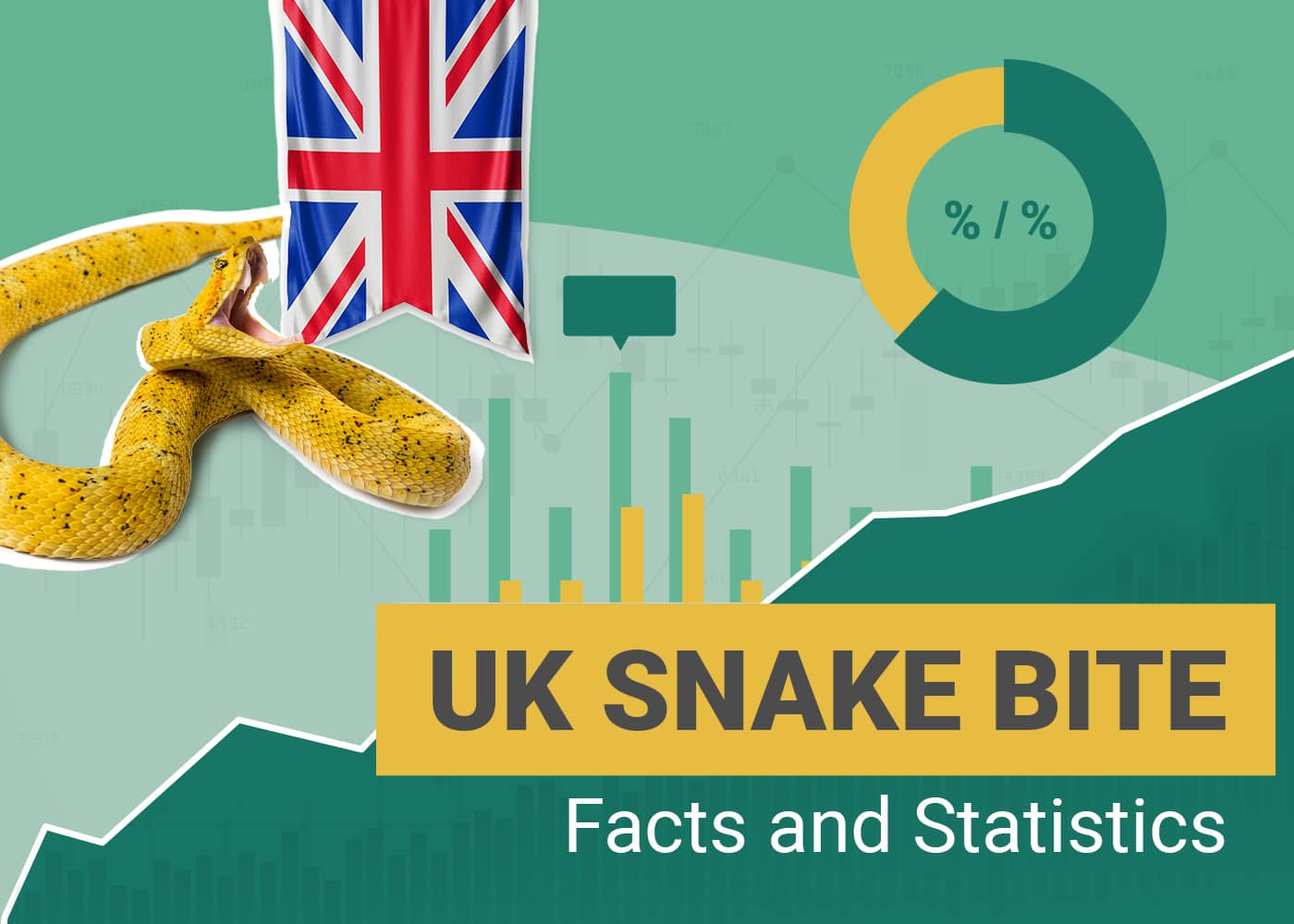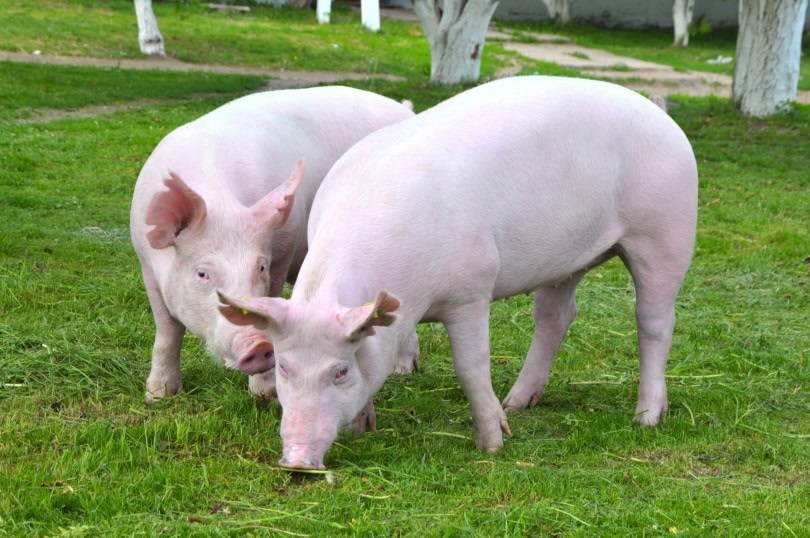Click to Skip Ahead
Note: This article’s statistics come from third-party sources and do not represent the opinions of this website.
Veterinary medicine is a crucial industry and an excellent career for animal lovers. It has exciting and rewarding jobs where you will be charged with providing care for millions of animals every day.
You may have heard different opinions about how long it takes to become a practitioner in this field. Extensive education, training, and experience are required before one can start practicing. Becoming a veterinarian in Canada takes an average of 6 years or longer.
Here, we share statistics to give you an understanding of what it takes to become a veterinarian in Canada, along with interesting facts.

The 10 Statistics on How Long It Takes to Become a Veterinarian in Canada
- The minimum time for the undergraduate veterinary program is 2 years, but the minimum time for the veterinary degree program is 4 years.
- To join a vet school in Canada, you will need to attend 1–2 years of a pre-veterinary program.
- You must complete all 4 years of vet school to specialize as a small animal or large animal veterinarian.
- Veterinary school in the U.S. takes 4 years, while it takes up to 6 years in Canada.
- While there is technically no age requirement for attending vet school, you cannot attend directly out of high school and have to complete at least 2 years of university education, meaning most people are at least 18 years of age and have completed high school.
- The Canadian Veterinary Medical Association (CVMA) is a professional veterinary association that licenses veterinarians across Canada after completing training.
- Just over 52,000 people are working in the veterinary industry, which has grown almost 5% over the past 5 years.
- After completing their studies, 80% of Canadian veterinarians work in private practice. The other 20% work in research institutions and government agencies.
- Veterinarians rank seventh for the most trusted profession in Canada.
- Only 10% of veterinary students come from rural areas.


How Long to Study to Become a Veterinarian in Canada
1. The minimum time for the undergraduate veterinary program is 2 years, but the minimum time for the veterinary degree program is 4 years.
(CANADIAN VETERINARY MEDICAL ASSOCIATION)
Becoming a veterinarian in Canada takes an average of 6 years or longer. A student must do at least a 2-year undergraduate degree in veterinary science.
The amount of time it takes to become a veterinarian varies depending on the person’s educational background, experience level, and the type of employment being pursued. However, the minimum time for the veterinary medicine degree program is 4 years. Additionally, the time it takes to become a veterinarian depends on the province or territory.
2. To join a vet school in Canada, you will need to attend 1–2 years of a pre-veterinary program.
(INDEED)
There are many steps to becoming a veterinarian in Canada. A pre-veterinary program is the first step.
You’ll also need to gain practical experience with animals through working as a veterinary assistant during your pre-veterinary program. It’s a valuable component of your education. You will help out with many different tasks, including managing animal records and caring for sick animals.
After this, you can proceed to a vet school. Before you apply to veterinary school, though, you must plan. Also, make sure you find a veterinary program that’ll fit you.

3. You must complete all 4 years of vet school to specialize as a small animal or large animal veterinarian.
(SGU)
Once you have completed pre-veterinary school, you may choose to specialize in one area of veterinary medicine. For example, you can become a small animal veterinarian treating animals like dogs and cats. Or you can be a large animal veterinarian specializing in animals like horses and cows. You can even become a general practitioner who treats both types of animals.
However, before you specialize in either, you must first complete the 4 years at a vet school.
All these veterinary fields take the same time to study. After this, you can become an intern in your first year out of veterinary school.
4. Veterinary school in the U.S. takes 4 years, while it takes up to 6 years in Canada.
(UOGUELPH)
Vet school in Canada is slightly different from the U.S. system. While it takes only 4 years in the U.S., it can take up to 6 years in Canada. Vet students in the U.S. only have to take eight required courses in those 4 years. This includes a clinical year where they work with animals at an approved veterinary facility.
Veterinary school in Canada takes longer because there are 12 required courses, including embryology, genetics, and others. There are also more exams and projects.
The time that one takes to complete vet school isn’t the only difference between the educational paths in these two countries. The prerequisites for admission differ too.
Also, some Canadian universities require applicants to have completed high school courses. That isn’t necessary for admission to vet schools in the United States. These differences make it necessary for prospective students to do their homework before deciding on a program.

Requirements to Join Vet Schools, Certifications, and Number of Vets
5. While there is technically no age requirement for attending vet school, you cannot attend directly out of high school and have to complete at least 2 years of university education, meaning most people are at least 18 years of age and have completed high school.
(UNIVERSITY OF CALGARY)
Canada’s veterinary medical licensing body has strict requirements for those aspiring to become veterinarians. A high school diploma is one of them, meaning you must first finish high school. Applicants must also have the equivalent of 2 years of university education in biology, chemistry, math, and physics. This means that at an absolute minimum, you’ll be at least 18 before you can even consider applying.

6. The Canadian Veterinary Medical Association (CVMA) is a professional veterinary association that licenses veterinarians across Canada after completing training.
(CANADIAN VETERINARIANS)
The CVMA lists the licensure requirements for veterinarians who want to practice in each province in Canada. It has a wide range of information about becoming a veterinarian. It includes salaries and job outlooks for veterinarians and veterinary technicians.
- Related read: What and When Is Veterinary Technician Week?
7. Just over 52,000 people are working in the veterinary industry, which has grown almost 5% over the past 5 years.
(IBIS WORLD)
The Canadian veterinary services industry is a stable $6.2-billion enterprise that continues to grow. The number of veterinarians in Canada has risen steadily over the last decade, with a growth of roughly 5% over the past 5 years.
As the pet industry is experiencing growth, there is an increased demand for pet care and services. The increase in demand will create new career opportunities for individuals interested in pursuing this field.
Tasks performed by veterinarians now include surgical procedures and drug therapies, animal research, toxicology, and public health concerns.

Veterinarians’ Fields of Work
8. After completing their studies, 80% of Canadian veterinarians work in private practice. The other 20% work in research institutions and government agencies.
(CANADIAN VETERINARY MEDICAL ASSOCIATION)
The most common career path for Canadian veterinarians is private practice. Only a few go for government agencies and research institutions, as seen by the statistics ratio of 80% to 20%.
Many factors determine if a veterinarian chooses private practice or government work. These include the vet’s specialty, location, salary, and age. But in most cases, earnings in the private sector are more lucrative compared to the government agencies.

9. Veterinarians rank seventh for the most trusted profession in Canada.
(ANIMAL HOSPITAL OF UNIONVILLE)
Of course, public opinion matters when it comes to your animal’s well-being. According to a poll done by Reader’s Digest Canada, veterinarians are some of the most trusted professionals in the country. They scored even higher compared to previous years, and they rank among other top professions, including firefighters, pharmacists, pilots, nurses, general practitioners, teachers, dentists, daycare workers, and those in the armed forces.
10. Only 10% of veterinary students come from rural areas.
(AGRICULTURE)
Veterinary medicine is at a critical juncture. The profession is facing an unprecedented shortage of practitioners. Despite recent efforts to encourage more people to consider careers in veterinary medicine, the gap between supply and demand remains wide.
In rural areas, the shortage of veterinarians is even more acute because of the low population. Rural animal practices are known to be challenging and often uncomfortable. The hours are long, and the pay is not as high as in urban or suburban areas.
This may not be the case for other areas of practice, such as cardiology or oncology. But there are plenty of rural communities that don’t have access to veterinary care at all.

Frequently Asked Questions
What are the requirements for joining a vet school in Canada?
Many veterinary schools in Canada are members of the CVMA. A few schools are independent and not members. All vet schools have their own admission requirements.
To apply to a Canadian veterinary school, you’ll need a high school education. Also, you must take the Graduate Assessment for Medical Students exam (GAMSAT). It tests your problem-solving skills and knowledge of scientific principles and concepts.
Maybe your undergraduate studies were in another field, such as zoology or biology. If so, you can substitute that exam for the GAMSAT and apply directly to a vet school.
Most vet schools also interview candidates as part of their admission process. Some vet schools ask students to submit an essay on why they want to be veterinarians. Others ask applicants to design and present a research poster.
(CVMA)

What are the five best vet schools in Canada?
Believe it or not, there are only five veterinary colleges in Canada, which are the University of Calgary, The Ontario Veterinary College, the University of Montreal, The Atlantic Veterinary College, and The Western College of Veterinary Medicine.
Graduates can work in various animal care facilities, including general-practice clinics, specialized veterinary hospitals, research facilities, and welfare organizations. Also, one can travel the world as an animal charity representative.
(CANADIAN VETERINARIANS)
What fields can you specialize in when attending a vet school in Canada?
There are two primary areas you can get into: small animal practice or large animal practice. Depending on the school, you may be able to choose both fields. In some universities, you can specialize in a particular technique or a specific group of animals.
One field of specialization is aquatic veterinary medicine. Here, you’ll work with fish and other aquatic animals. Veterinarians treat infections, parasites, and injuries sustained by fish while they’re being transported or stored.
There are also zoo veterinarians. These are professionals who care for animals in zoos. They are also responsible for a lot of veterinary care during transportation. Veterinarians should know the anatomical and physiological differences between wild and domestic animals.
Another field of specialization is research. Veterinarians in this field create vaccines to prevent disease. Also, they may work with human health professionals when outbreaks occur.
If you have a passion for horses but aren’t sure what kind of career to pursue, consider studying equine medicine. It’s an excellent choice for people who want to work with these animals.
What is the cost of becoming a veterinarian in Canada?
The average annual cost of tuition in Canada is roughly 15,000 CAD per year.
Tuition fees vary depending on the school. There are three different kinds of schools in Canada. The least expensive is the community college. Next are the colleges of applied arts and technology. Finally, there are universities. These cost more than the other two.
To get a rough figure of the total cost, you need to consider what veterinary school you will attend, the kind of license you will get, and whether you have any other costs not included in the tuition.
(UNIVERSITY OF SASKATCHEWAN)

Why are vets in demand in Canada?
Veterinarian is one of the most sought-after careers in Canada due to the growing population of pets, more specifically cats and dogs, and health concerns that plague wild and domestic animals alike.
Canada has had a long history of caring for animals, from wildlife to companion animals. There is also a greater awareness of animal welfare issues. It has increased demand as people become more educated on the needs of companion animals.
What education requirement do you need to be a large animal vet?
Large animal vets are also known as livestock veterinarians. To become a large animal vet, you must complete a doctoral degree in veterinary medicine. It will give you the basic knowledge and skills necessary for clinical work.
Some universities also offer postgraduate degrees, such as master’s and Ph.D. degrees. These are useful for gaining further knowledge of specific fields, such as animal welfare or genetics.
(CHRON)
What is the difference between pre-veterinary medicine and veterinary medicine?
Pre-veterinary medicine is an undergraduate degree program that prepares students for veterinary school. Pre-veterinarians study animal biology, anatomy and physiology, parasitology, microbiology, and other courses. It gives them a foundation of the basic science knowledge required to become veterinarians.
Veterinary medicine is the clinical practice of healing sick or injured animals. After completing an undergraduate pre-veterinary program, pre-veterinarians are admitted to a 4-year professional veterinary degree program at one of the Canadian veterinary schools.
(CHRON)

Becoming a Veterinarian in Canada
Many people are interested in becoming veterinarians, but only a few follow this path. It takes a lot of hard work and dedication to become a vet. You have to prepare yourself for this long and challenging process that will take several years to complete.
You must complete at least 1 or 2 years of pre-veterinary school. You can then pursue undergraduate study at an accredited university or veterinary school, where you’ll be trained in anatomy, physiology, pathology, pharmacology, anesthesia, and surgery.
You will then move on to an actual veterinary school. This includes hands-on experience with animals. You’ll get valuable experience working with animals under supervision from licensed veterinarians.
Also, you must write the Canadian Veterinary Medical Exam (CVME). It’s administered by the National Examining Board of Canada. The CVME has two parts. Part one covers general veterinary knowledge, while part two covers clinical knowledge.


Conclusion
Veterinarians are the primary source of healthcare for companion and farm animals. They examine pets, livestock, and zoo animals periodically. They also diagnose medical conditions and prescribe treatments.
Becoming a veterinarian in Canada will take an average of 6 years, from high school to graduation from veterinary college. The vet profession is a highly specialized one. You can explore a wide range of paths of working with animals after you graduate from veterinary school.
The veterinary path in Canada is lengthy, but it’s worth the time and effort for those passionate about the career. Becoming a veterinarian opens up opportunities for you to have a truly fulfilling profession.
Featured Image Credit: SvetikovaV, Shutterstock










